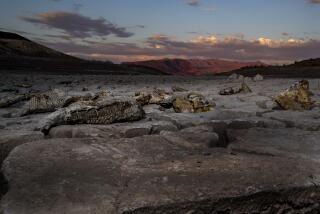City of Lawns and Illusions
- Share via
California, Teddy Roosevelt once said, is west of the West, and most years that description holds true, at least for the part of the state west of the Sierra Nevada.
To find the iconic American West, arid and empty, a coastal Californian typically heads east, leaving the Pacific behind to reach an ocean of sagebrush.
But this parched summer, the distance between Southern California and its Southwestern neighbors seems much shorter. Reminders abound that this region we inhabit is desert and that we share scarce sources of water.
In New Mexico, Albuquerque Mayor Martin Chavez wants to tear out public golf courses. Santa Fe is on Stage 3 water alert; Stage 4 shuts down development entirely and halts already restricted lawn-watering and car-washing. City officials are talking about trucking in water from Washington state.
Tiny Aztec, N.M., is preparing to call for Stage 4 restrictions should the Animus River--full of rocks and sand this year instead of the usual summer rafters--run completely dry. In Los Ojos, where a weaving cooperative provides much-needed jobs, the asters and other wildflowers used to dye wool produce pallid traces of their usually vivid blues and reds.
Without rafters, without dye for weavers (or worse, without buyers), the drought has financial import. The tourists who were expected to stay closer to home in this year of terrorist attacks stayed even closer than projected, or at least away from New Mexico, Arizona and Colorado, where wildfires rained ash throughout June. Or maybe it’s the tumbling stock market that has made parking possible in front of Santa Fe boutiques and galleries.
Thankfully, midsummer storms arrived on schedule to douse the fires. But the booms of thunder that send young children and old dogs running for comfort bring what New Mexico’s Pueblo Indians call male rain--fast and furious--not the gentle, steady female rains that end droughts.
Los Angeles is no stranger to fire and drought. We’ve learned from past disasters, setting standards for fire-resistant building materials and landscaping. Residents have cut per capita water consumption, one low-flush toilet at a time, even as the region’s population grows.
Even so, even after the driest year on record, even as we watch flames lap perilously close to giant Sequoias and worry about houses in tinder-dry canyons, Los Angeles remains a city of lawns and illusions. More populated and prosperous than much of the West, true. But more a part of it than we like to imagine.
More to Read
Sign up for Essential California
The most important California stories and recommendations in your inbox every morning.
You may occasionally receive promotional content from the Los Angeles Times.













